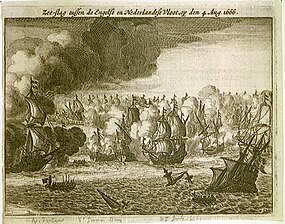St. James's Day Battle
| St James' Day Battle | |||||||
|---|---|---|---|---|---|---|---|
| Part of the Second Anglo-Dutch War | |||||||
 Engraving showing the St. James Day battle August 4th, 1666 between English and Dutch Ships |
|||||||
|
|||||||
| Belligerents | |||||||
|
|
|
||||||
| Commanders and leaders | |||||||
| Prince Rupert of the Rhine and George Monck, 1st Duke of Albemarle | Michiel de Ruyter | ||||||
| Strength | |||||||
| 90 ships, plus 16 fireships | 89 ships, plus 20 fireships and 9 yachts | ||||||
| Casualties and losses | |||||||
| 1 English ship (Resolution) sunk, ca 300 killed | 2 Dutch ships (Sneek and Tholen) taken, ca 800 killed | ||||||
Coordinates: 51°22′01″N 1°36′00″E / 51.367°N 1.600°E
The naval St James' Day Battle (also known as the St James' Day Fight), the Battle of the North Foreland and the Battle of Orfordness) took place on 25 July 1666 — St James' day in the Julian calendar then in use in England (4 August 1666 in the Gregorian calendar), during the Second Anglo-Dutch War and was fought between fleets of England, commanded jointly by Prince Rupert of the Rhine and George Monck, 1st Duke of Albemarle, and the United Provinces commanded by Lieutenant-Admiral Michiel de Ruyter. In the Netherlands, the battle is known as the Two Days' Battle.
After the Dutch had inflicted considerable damage on the English fleet in the Four Days Battle, the leading Dutch politician, Grand Pensionary Johan de Witt, ordered Lieutenant-Admiral Michiel de Ruyter to carry out a plan that had been prepared for over a year: to land in the Medway to destroy the English fleet while it was being repaired in the Chatham dockyards. For this purpose, ten fluyt ships carried 2,700 marines of the newly created Dutch Marine Corps, one of the first in history to be specialised in amphibious landings. Also, De Ruyter was to combine his fleet with the French one.
...
Wikipedia
